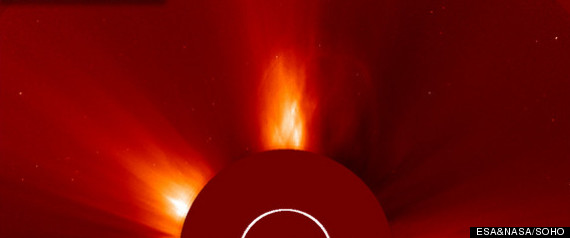You are here
Solar Flare 2013: Intense Sun Eruption Aimed At Earth, Scientists Say
Primary tabs
Huffington Post - February 10, 2013 (Updated February 11, 2013) - Tariq Malik
A long-lasting solar flare erupted from the sun early Saturday (Feb. 9), triggering an intense sun eruption aimed squarely at Earth. The solar storm, however, should not endanger satellites or astronauts in space, but could amplify auroras on Earth, NASA says. The solar eruption —called a coronal mass ejection —occurred at 2:30 a.m. EST (0730 GMT) on Saturday during a minor, but long-duration, flare. It hurled a wave of charged particles at Earth at speeds of about 1.8 million miles per hour (nearly 2.9 million km/h).
Coronal mass ejections, or CMEs, are eruptions of charged solar material that fling solar particles out into space. When aimed at Earth, they can reach the planet between one and three days later, and cause geomagnetic storms when they interact with the planet's magnetic field. They can also amplify the northern and southern lights displays over the Earth's poles.
"In the past, CMEs at this strength have had little effect," NASA officials said in a statement. "They may cause auroras near the poles but are unlikely to disrupt electrical systems on Earth or interfere with GPS or satellite-based communications systems."

Coronal mass ejection (CME) released by the sun on Feb. 9, 2013 as seen by the Solar and Heliospheric Observatory (SOHO).



Comments
Major Solar Flare Erupts From the Sun
space.com - October 23, 2012
According to scientists at NASA, 2013 will be a year of peak magnetic activity for the sun. The solar flare of February 9 is one of many possible events that could lead to solar material interacting with the Earth's magnetic field.
Solar flares often release bubbles of charged plasma (called coronal mass ejections) into space that, when they impact Earth, can cause geomagnetic storms that disrupt radio communications and power grids and create especially beautiful displays of the northern and southern lights (auroras). This flare [of Oct 22, 2012], however, did not unleash a coronal mass ejection, so it is predicted to cause little disruption on Earth and no special auroras. Its powerful radiation was enough, though, to briefly disrupt radios here last night.
Read entire article
Could the Effects of Solar Flares be Catastrophic?
www.wnd.com - January 20, 2013 - F. Michael Maloof
F. Michael Maloof seems to think so.
Scientists from the National Aeronautic and Space Administration and the National Oceanographic and Atmospheric Administration say this reveals the potential for a solar storm maximum as the sun approaches the height of its latest 11-year cycle this year and next.
Flares are expected to continue into 2020.
Scientists at these space-watch agencies say that if Earth gets a direct hit from one of these solar flares – some of which can be up to four times the size of Earth – the damage could be enormous.
The United States alone would sustain damages up to $2 trillion the first year to the nation’s electric grid-dependent critical infrastructures. In addition, it could leave some 160 million people – more than half the population of the United States – starving because of the collapse of food and fuel delivery systems.
All of these systems are vulnerable to an electromagnetic pulse, or EMP, a high-intensity burst of electromagnetic energy for which solar flares are but one source. Another source would be from a high-altitude nuclear explosion.
Read entire article
In his book, A Nation Forsaken, Maloof outlines how scientists and other experts have warned for years that the nation’s electrical grid system, together with other critical infrastructures that have an almost complete dependency on electricity and electronic components, are highly vulnerable to an electromagnetic pulse event, either from natural (solar flare) or man-made (nuclear) causes.